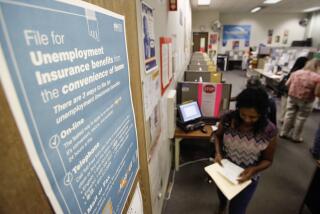Personal Income Takes 1st Drop in Year in May : Spending Surges 0.9% as Consumers Dip Into Savings for Car Buying
- Share via
WASHINGTON — A sharp drop in government subsidy payments to farmers contributed to a 0.1% decline in personal income in May, the first setback in cumulative earnings in a year, the Commerce Department reported Thursday.
However, the decline in personal income was accompanied by a strong 0.9% increase in consumer spending, led by gains in car sales. It was the best advance in five months.
Still, many analysts worried that consumer spending will slow in the months ahead because of continued weakness in income growth.
“If we don’t get some improvement in the job market and in wage growth, I don’t see how much longer the consumer can keep carrying the economy,” said Sandra Shaber, director of consumer economics at Chase Econometrics, a forecasting concern.
The 0.1% income decline, which followed a 1.2% jump in April, was the first downturn since a 0.5% drop in May, 1985.
Big Swing in Subsidy Payments
The April rise and the May decline both were exaggerated by a big swing in government subsidy payments to farmers, which soared in April, only to plunge back to normal levels last month. Excluding the subsidy payments, personal income would have risen 0.3% in April and 0.4% in May.
Still, analysts expressed concern that wage and salary growth has been particularly anemic in the past two months, rising by just 0.2% in May as a loss of 212,000 manufacturing and oil industry jobs depressed income growth. Changes in wages and salaries are watched closely by economists, who believe that they foreshadow consumer spending patterns better than other income components.
The 0.9% jump in personal consumption spending last month was the strongest increase since a 1.8% advance in December. It followed a 0.5% gain in April.
The rise was fueled by strong increases in purchases of both durable and non-durable goods. Purchases of durable goods--items expected to last three or more years--rose at an annual rate of $13 billion in May after advancing at a $15.2-billion rate in April, reflecting strength in car sales in both months. Purchases of non-durable goods climbed $5 billion in May after falling $9.7 billion in April.
Americans had to dip into savings to finance their May spending spree. Personal savings as a percentage of disposable income slipped back to 4.3% last month from 4.7% in April. Savings is expressed as a percentage of disposable, or after-tax, income. Disposable income dropped 0.2% in May following a 1.4% increase in April.
In the income category, the tiny 0.2% increase in wages and salaries came from an overall increase of $3.7 billion, at an annual rate, in May, following a $2.7-billion April gain.
Farm income fell $11.5 billion in May after soaring by $33.7 billion in April. The wide swing came from government subsidy payments that surged in April because they included advance payments for 1986 and final payments for 1985.
Excluding these subsidy payments, farm income increased by $4.8 billion in May and $1.6 billion in April.
More to Read
Inside the business of entertainment
The Wide Shot brings you news, analysis and insights on everything from streaming wars to production — and what it all means for the future.
You may occasionally receive promotional content from the Los Angeles Times.










